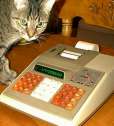Casio fx-5500L
| Datasheet legend
Ab/c:
Fractions calculation
AC: Alternating current BaseN: Number base calculations Card: Magnetic card storage Cmem: Continuous memory Cond: Conditional execution Const: Scientific constants Cplx: Complex number arithmetic DC: Direct current Eqlib: Equation library Exp: Exponential/log functions Fin: Financial functions Grph: Graphing capability Hyp: Hyperbolic functions Ind: Indirect addressing Intg: Numerical integration Jump: Unconditional jump (GOTO) Lbl: Program labels LCD: Liquid Crystal Display LED: Light-Emitting Diode Li-ion: Li-ion rechargeable battery Lreg: Linear regression (2-var. stats) mA: Milliamperes of current Mtrx: Matrix support NiCd: Nickel-Cadmium recharg. batt. NiMH: Nickel-metal-hydrite rech. batt. Prnt: Printer RTC: Real-time clock Sdev: Standard deviation (1-var. stats) Solv: Equation solver Subr: Subroutine call capability Symb: Symbolic computing Tape: Magnetic tape storage Trig: Trigonometric functions Units: Unit conversions VAC: Volts AC VDC: Volts DC |
| ||||||||||||||||||||||||||||||||||||||||||||||||||||||||
Casio fx-5500L
 A somewhat atypical model, the Casio fx-5500L is a scientific calculator with limited programmability in the form of formula storage. It does have a fair amount of space for formula storage, but it lacks conditional expressions and other forms of program control.
A somewhat atypical model, the Casio fx-5500L is a scientific calculator with limited programmability in the form of formula storage. It does have a fair amount of space for formula storage, but it lacks conditional expressions and other forms of program control.
Storage for formulae in this calculator is organized in two levels. A single formula can be stored, recalled, and executed in a current storage area. Additional formulae can be stored in the formula memory, and recalled into the current storage area for execution.
For instance, consider my standard example, the Gamma function, for which a formula is provided below. To add this formula to the calculator's formula memory, first enter the formula, then press [Shift] [CALC] [SET]. Later, the formula can be recalled by pressing [Shift] [CALC] [f], using the up and down-arrow keys to locate the desired formula, and then by pressing the [IN] button to move the formula to the current storage area.
To compute the Gamma function (actually, the natural logarithm thereof) to 10+ digit accuracy for arguments greater than 5, you can use Stirling's formula as follows:
G=X×ln X-X+ln √(2×π/X)+((((1/1188/X²-1/1680)/X²+1/1260)/X²-1/360)/X²+1/12)/X


